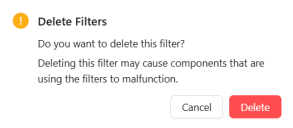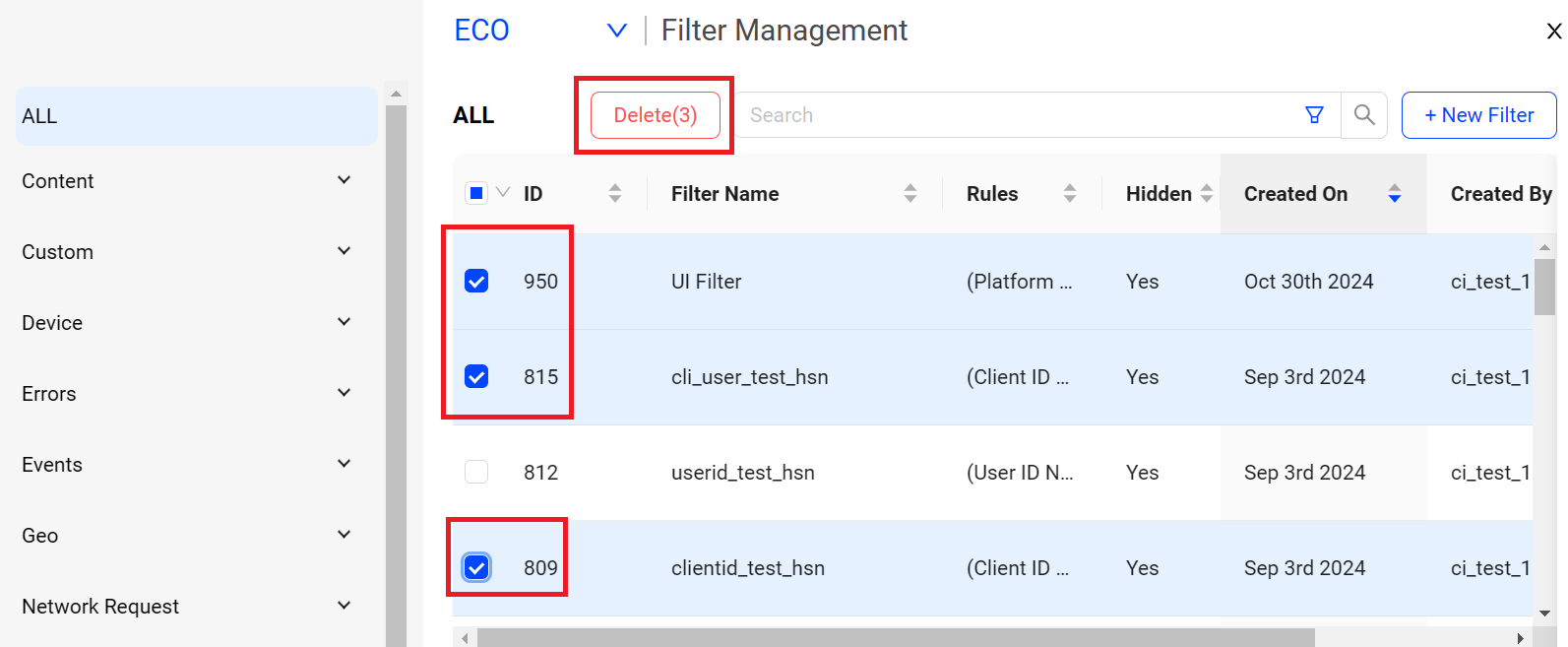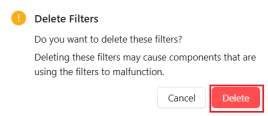Efficient filter monitoring involves both ensuring you have the filters you need and deleting those you don’t need. This keeps your filters list concise so Pulse users can easily find and use the right filters.
Note: You can easily manage large numbers of filters using the bulk_filters API. For more details, see Bulk Filters API at https://developer.conviva.com.
Click on the Settings icon and select Filter Management.
The Filter Management screen categorically displays all the filters. You can change the order in which they appear by clicking on any of the column headings.
For example:
Sort by Created On to see filters based on the day it was created.
The example below shows filters sorted by the filter creation date.

The left category menu lists the different categories. You can sort the filters based on the categories.
Select any filter on the left panel to sort the filter data.
In this example, the data is sorted based on the Country.

Creating Filters
-
Click Filters in any dashboard page.
-
Click Create New Filter.
-
Enter a name for the new filter.
-
Define the rule for the new filter.
-
Select field (pre-defined or custom dimension).
-
Choose a comparison (for example, "equals", "not equals", "contains", "not contains).
-
Select a value.
-
-
Choose a category.
The example below shows how to create a filter for Roku players in Brazil.

-
The filter name is displayed in DPI when you use the filter, so Conviva recommends descriptive names that are easy to differentiate yet use limited space efficiently.
-
Rules consist of a field, a comparison (equals, not equals and sometimes contains, not contains depending on the field) and the value.
-
To create a filter with multiple rules, click +AND button and add the details as required. Also, you can add a group filter by clicking +Group button.
Adding a group filter will create a logical OR group and individual filter will create a Logical AND hierarchically.
-
Legacy Diagnostics and Alerts have been deprecated and may not be available in your account. If you do have access to them, Conviva does not recommend using them for new filters.
-
You can use new filters immediately, but they would not have any data at first. Wait at least 5 minutes for the new data points to appear in your dashboards.
Editing Filters
Before editing a filter, ensure you understand the potential impact of your changes.
Changing a filter's name or category does not impact the collected data. However, any other modifications will alter how data is collected in the future.
For example, if you remove the flag for Top Rising Content, you will no longer be able to use those filters on that dashboard.
To edit a filter:
-
In the filter Management screen, click the kebab icon next to the desired filter and select Edit from the drop-down.

-
Edit the filter as required and click Save. Edit Filter page automatically populates with the values from the filter you selected.

Searching for Filters
You can search for a filter by Name, Creation Date, Created On, or Created Byfields.
-
Type a search term in the search box and press Enter. In this example, we search for the term "New Zealand":

Cloning Filters
You can clone a filter, and save the filter in a different name.
-
In the filter Management screen, click the kebab icon next to the desired filter and select Clone from the drop-down.

-
Clone Filter screen is displayed. Edit the details as required and click Save. Clone Filter page automatically populates with the values from the filter you selected.

Deleting Filters
Delete filters individually or bulk from the filter management screen to streamline the filter list.
Note: A filter linked to a Conviva object, such as an alert or daily email, cannot be deleted. To remove this type of filter, delete the associated objects first.
Delete filter induvidualy or as a group of multiple filters.
-
To delete a single filter, click the kebab icon next to the desired filter and select Delete from the drop-down.
Image: Delete Filter

Click Delete to confirm the deletion.
Image: Delete Filter

-
To delete multiple filters, select the checkbox next to the filter IDs of the desired filter and click the Delete button, to see the Delete Filters popup screen.
Use the search feature to limit the displayed filters by filter ID, such as "200" for filters with this number in the ID.
Image: Delete Filter

Click Delete to confirm the deletion.
Image: Delete Filters

Managing Filters Deleting Filters Managing Filters Managing Filters